On stability for hybrid system under stochastic perturbations
The aim of this paper is to find out suitable conditions for almost surely exponential
stability of communication protocols, considered for nonlinear hybrid system under stochastic
perturbations. By using the Lyapunov-type function, we proved that the almost surely exponential
stability remain be guaranteed as long as a bound on the maximum allowable transfer interval
(MATI) is satisfied.
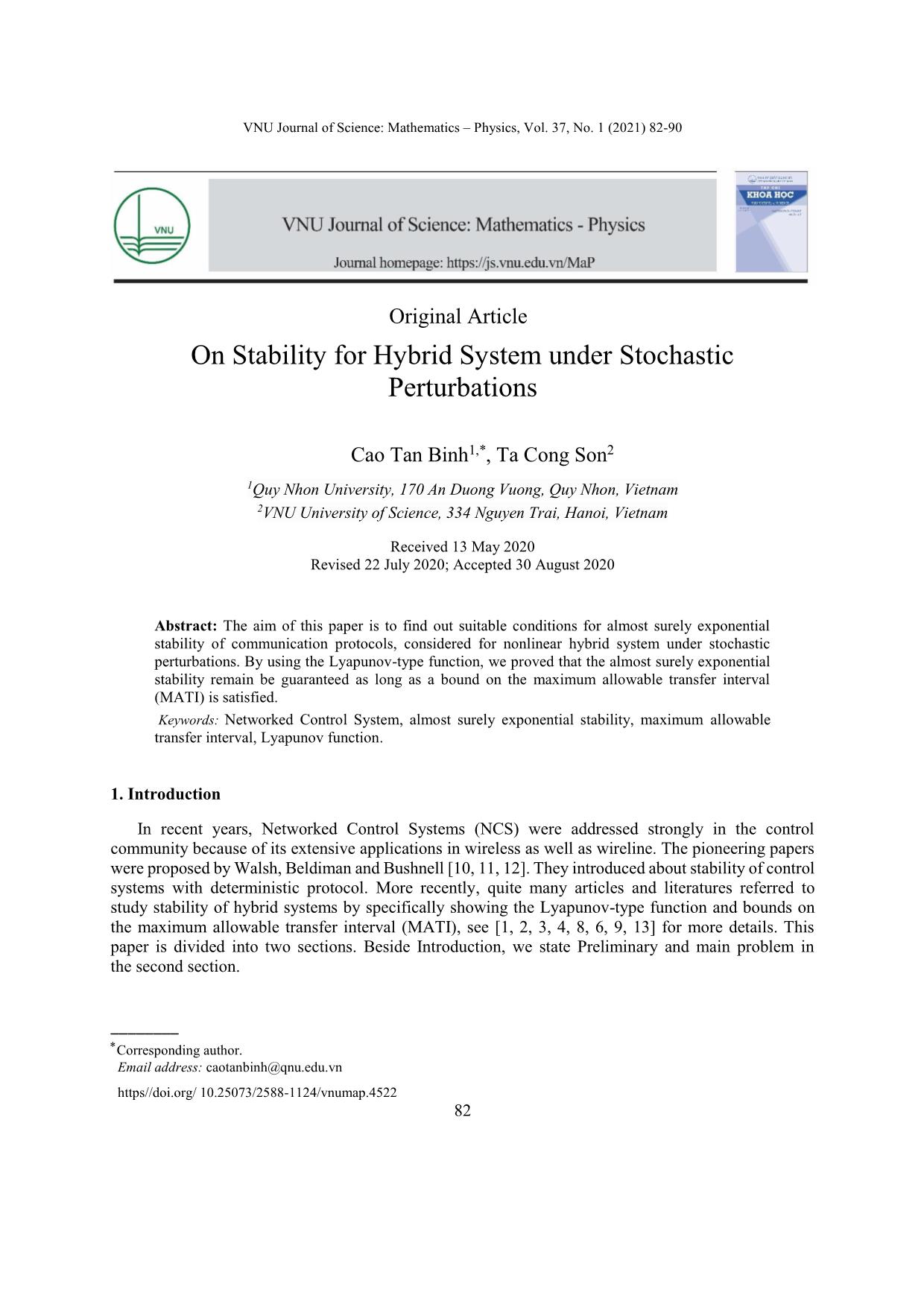
Trang 1
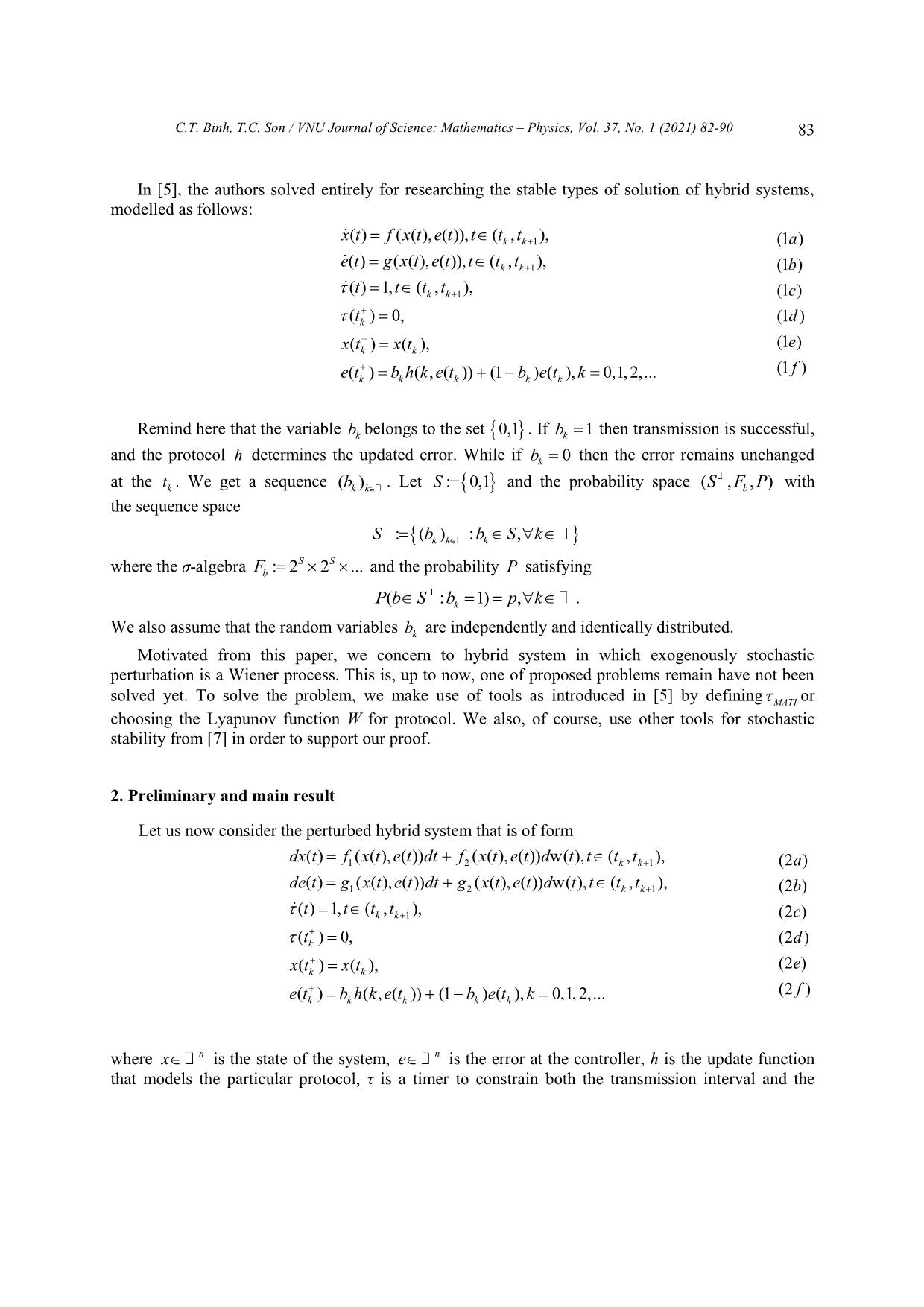
Trang 2
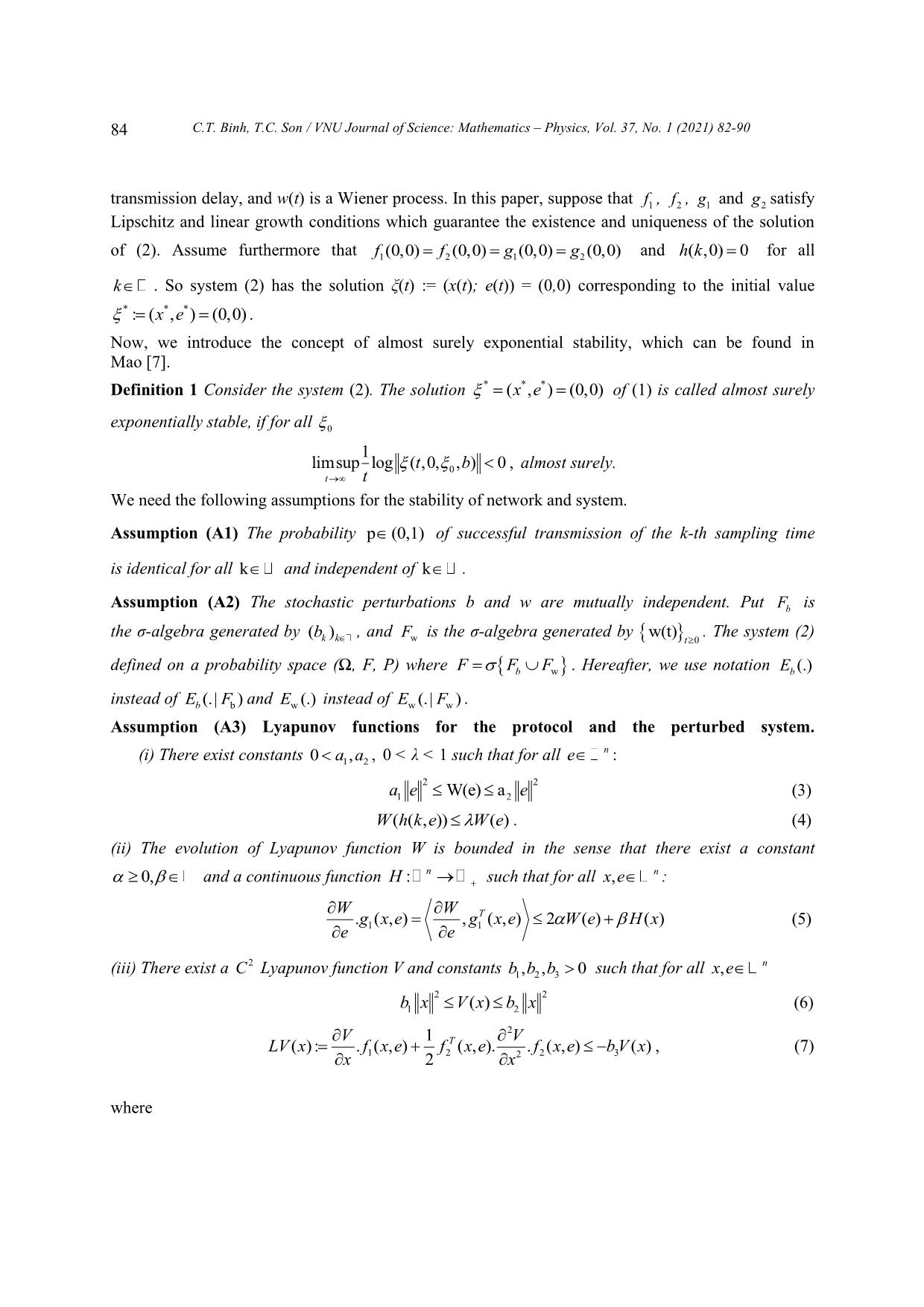
Trang 3
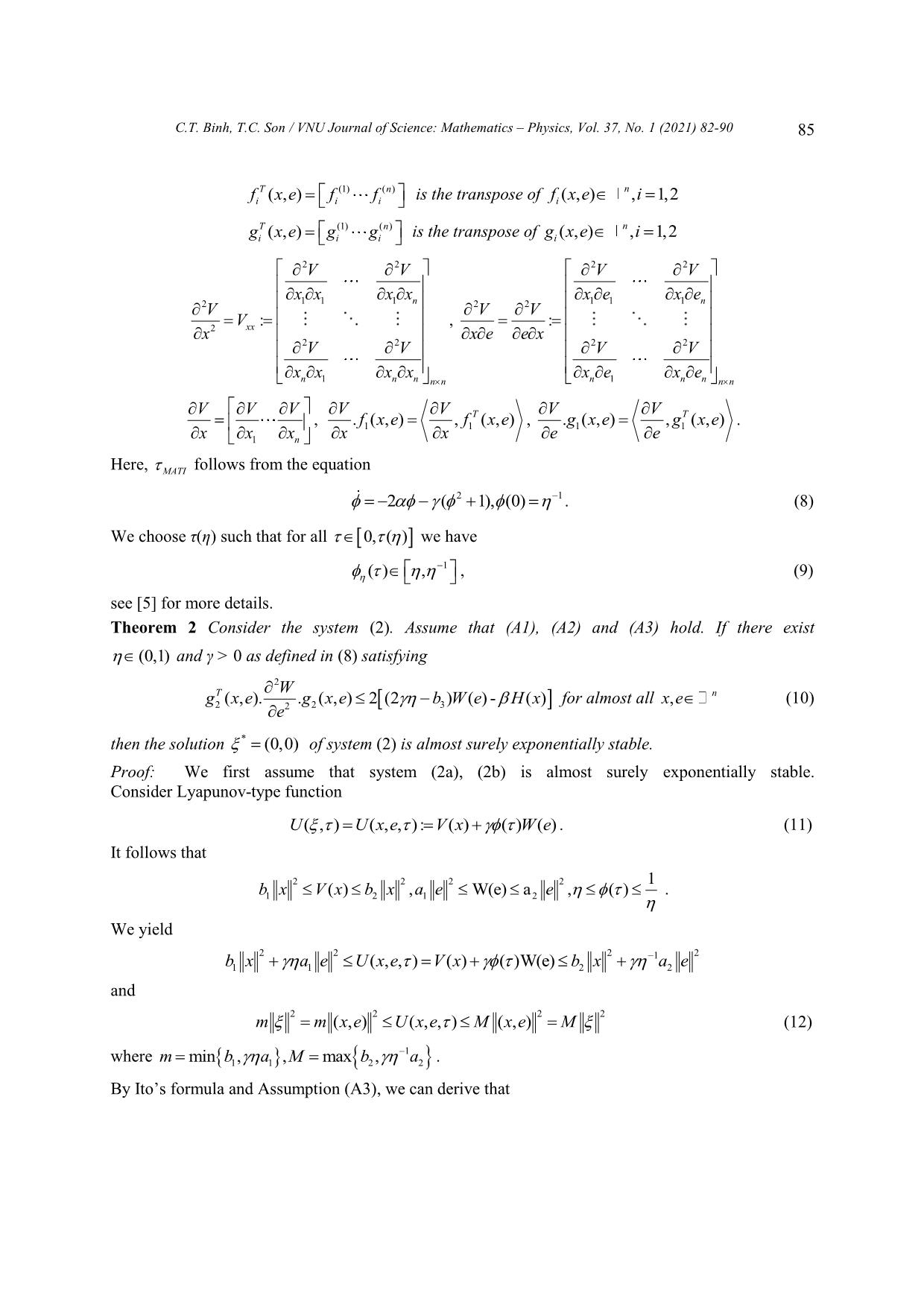
Trang 4
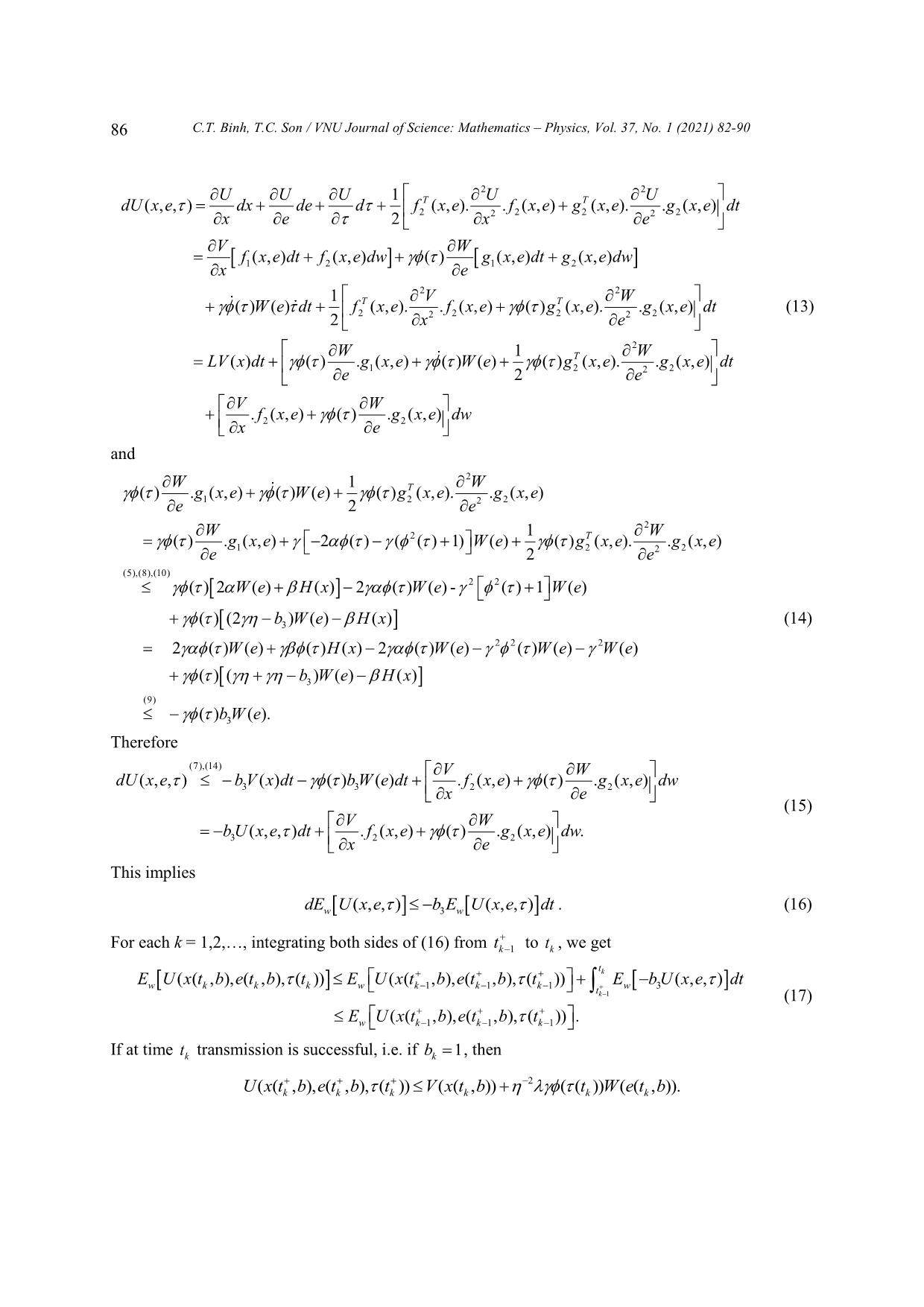
Trang 5
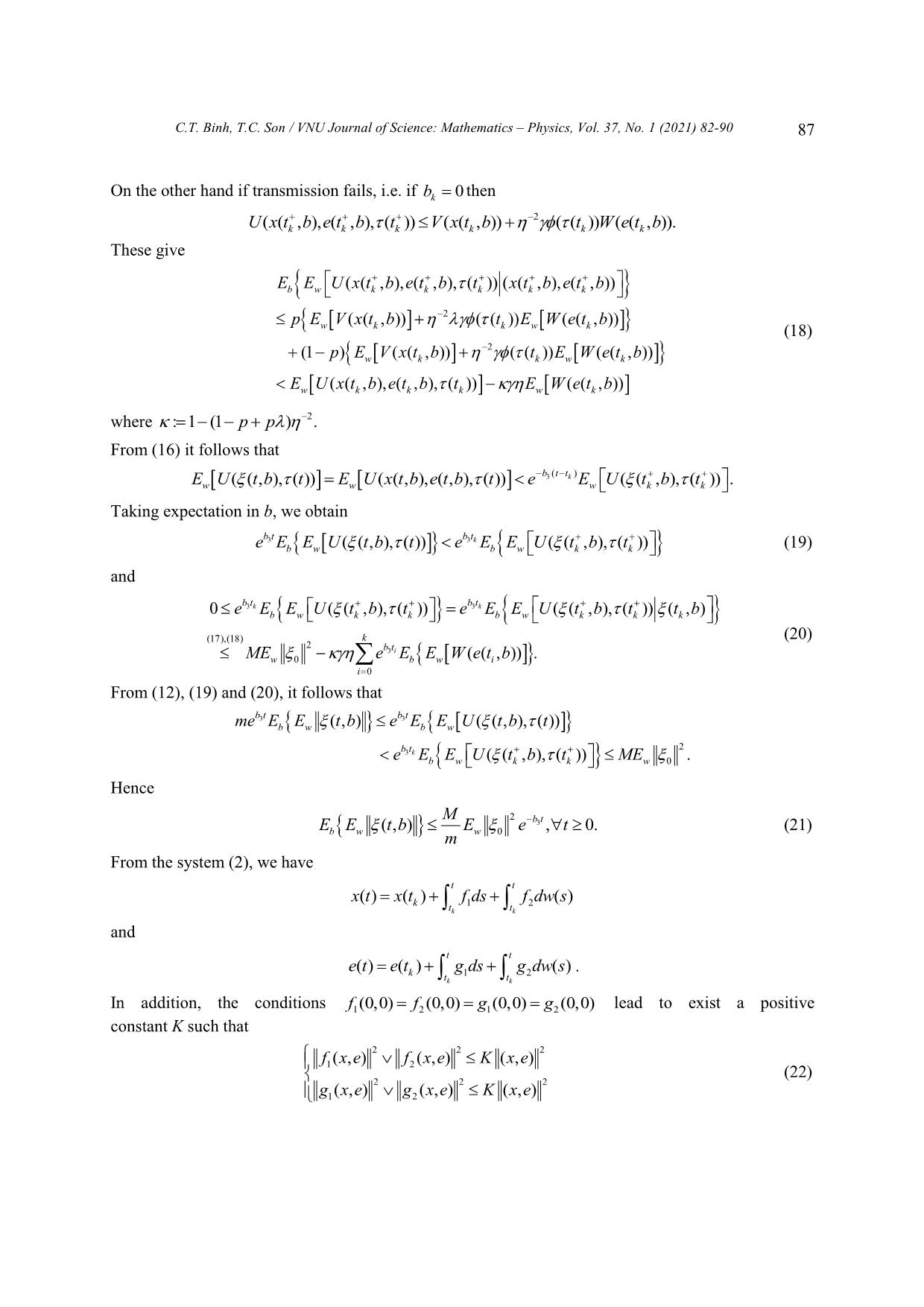
Trang 6
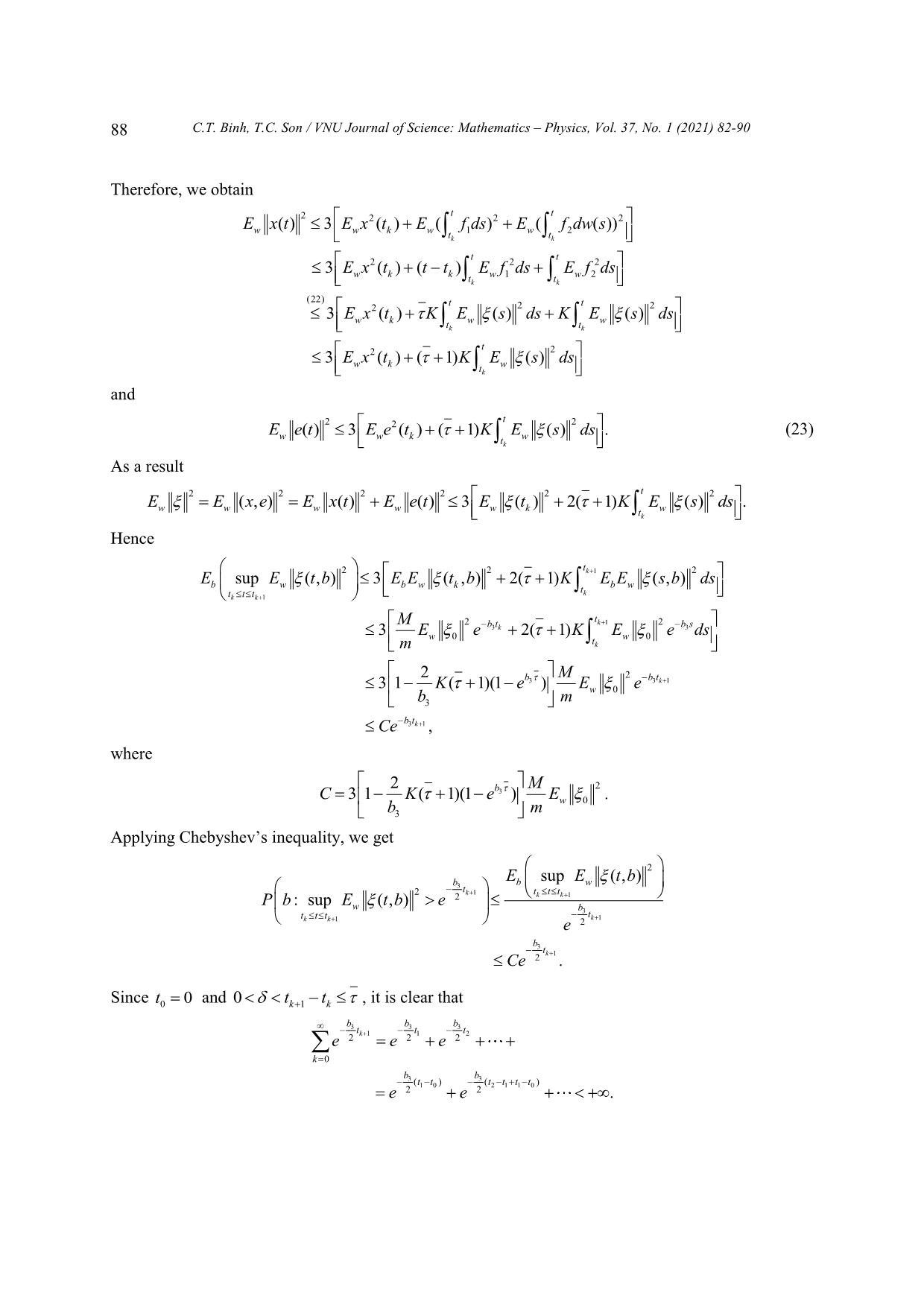
Trang 7
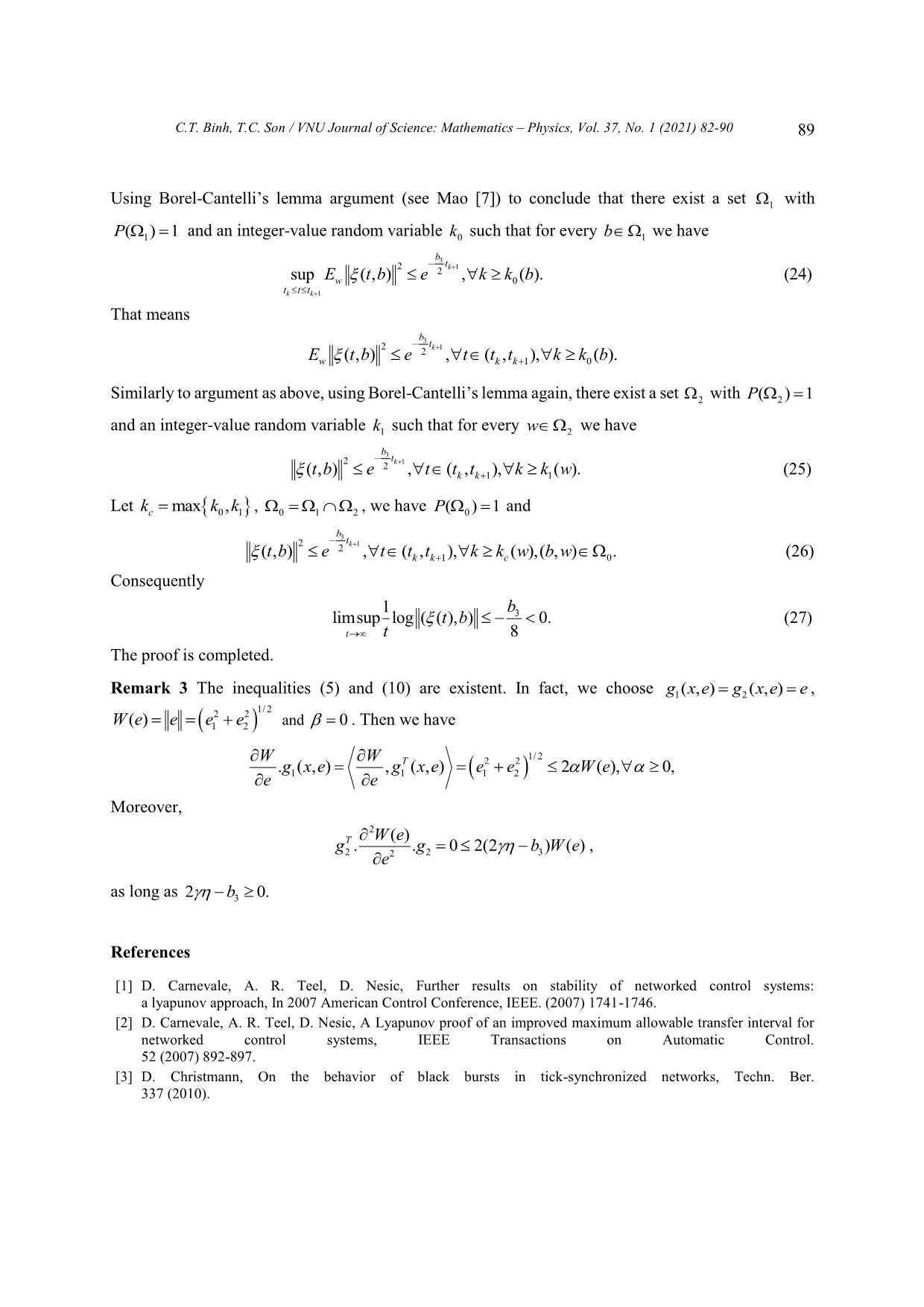
Trang 8
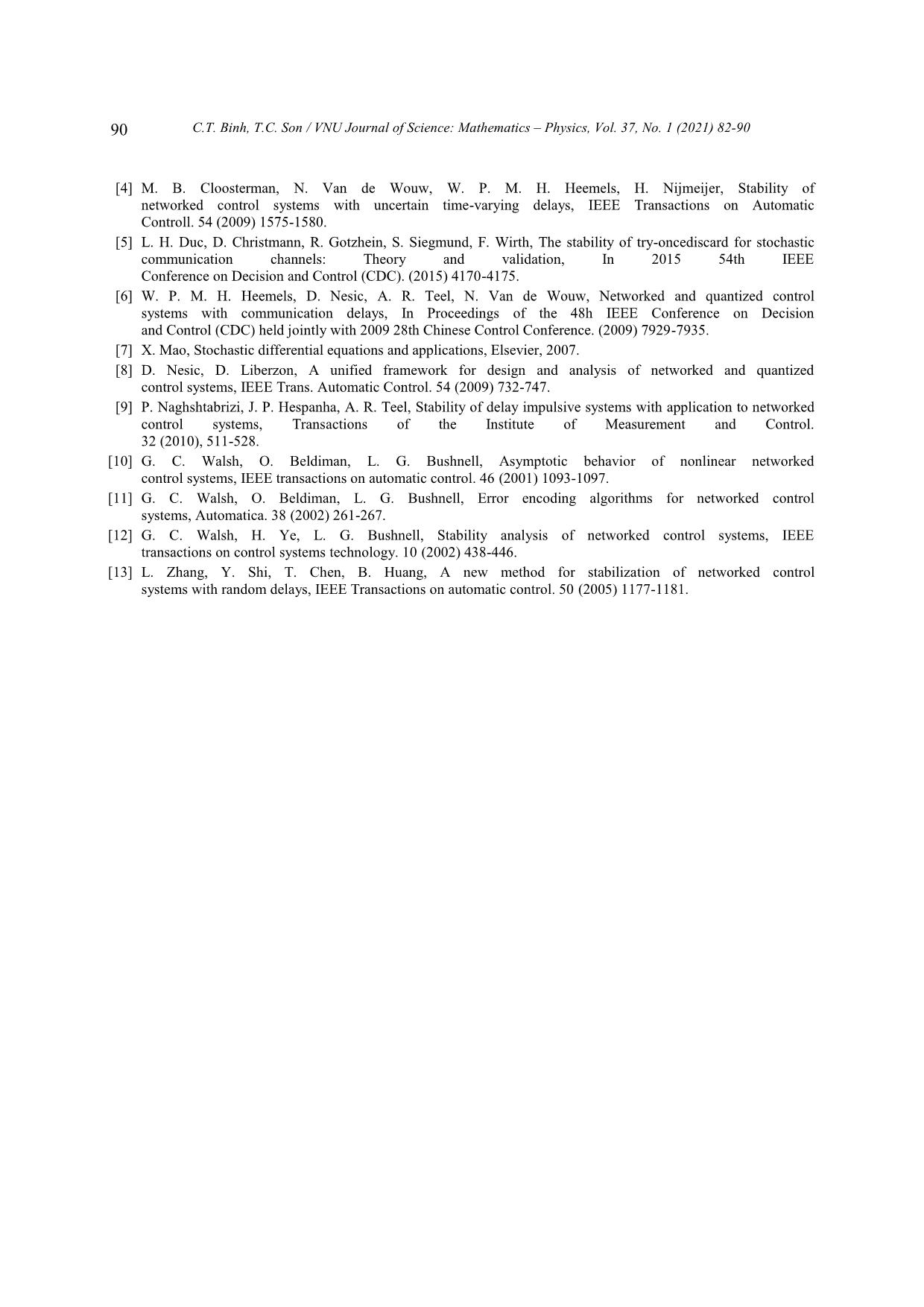
Trang 9
Bạn đang xem tài liệu "On stability for hybrid system under stochastic perturbations", để tải tài liệu gốc về máy hãy click vào nút Download ở trên
Tóm tắt nội dung tài liệu: On stability for hybrid system under stochastic perturbations
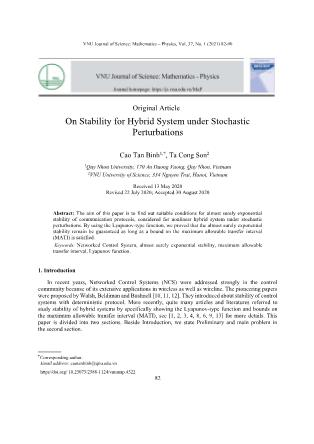
tion protocols, considered for nonlinear hybrid system under stochastic perturbations. By using the Lyapunov-type function, we proved that the almost surely exponential stability remain be guaranteed as long as a bound on the maximum allowable transfer interval (MATI) is satisfied. Keywords: Networked Control System, almost surely exponential stability, maximum allowable transfer interval, Lyapunov function. 1. Introduction In recent years, Networked Control Systems (NCS) were addressed strongly in the control community because of its extensive applications in wireless as well as wireline. The pioneering papers were proposed by Walsh, Beldiman and Bushnell [10, 11, 12]. They introduced about stability of control systems with deterministic protocol. More recently, quite many articles and literatures referred to study stability of hybrid systems by specifically showing the Lyapunov-type function and bounds on the maximum allowable transfer interval (MATI), see [1, 2, 3, 4, 8, 6, 9, 13] for more details. This paper is divided into two sections. Beside Introduction, we state Preliminary and main problem in the second section. ________ Corresponding author. Email address: caotanbinh@qnu.edu.vn https//doi.org/ 10.25073/2588-1124/vnumap.4522 82 C.T. Binh, T.C. Son / VNU Journal of Science: Mathematics – Physics, Vol. 37, No. 1 (2021) 82-90 83 In [5], the authors solved entirely for researching the stable types of solution of hybrid systems, modelled as follows: x() t f ((),()), x t e t t (, tkk t 1 ), (1a ) e() t g ((),()), x t e t t (, tkk t 1 ), (1b ) (t ) 1, t ( tkk , t 1 ), (1c ) (tk ) 0, (1d ) (1e ) x( tkk ) x ( t ), (1f ) et(k ) bhket k ( , ( k )) (1 betk k ) ( k ), 0,1,2,... Remind here that the variable bk belongs to the set 0,1 . If bk 1 then transmission is successful, and the protocol h determines the updated error. While if bk 0 then the error remains unchanged at the tk . We get a sequence ()bkk . Let S : 0,1 and the probability space (,,)SFPb with the sequence space S:():, bk k b k S k SS where the σ-algebra Fb : 2 2 ... and the probability P satisfying P( b S : bk 1) p , k . We also assume that the random variables bk are independently and identically distributed. Motivated from this paper, we concern to hybrid system in which exogenously stochastic perturbation is a Wiener process. This is, up to now, one of proposed problems remain have not been solved yet. To solve the problem, we make use of tools as introduced in [5] by defining MATI or choosing the Lyapunov function W for protocol. We also, of course, use other tools for stochastic stability from [7] in order to support our proof. 2. Preliminary and main result Let us now consider the perturbed hybrid system that is of form dxt() fxtetdt1 ((),()) fxtetd 2 ((),())w(), tt (, ttkk 1 ), (2a ) det() gxtetdt1 ((),()) gxtetd 2 ((),())w(), tt (, ttkk 1 ), (2b ) (t ) 1, t ( tkk , t 1 ), (2c ) (tk ) 0, (2d ) x( tkk ) x ( t ), (2e ) (2f ) et(k ) bhket k ( , ( k )) (1 betk k ) ( k ), 0,1,2,... where x n is the state of the system, e n is the error at the controller, h is the update function that models the particular protocol, τ is a timer to constrain both the transmission interval and the 84 C.T. Binh, T.C. Son / VNU Journal of Science: Mathematics – Physics, Vol. 37, No. 1 (2021) 82-90 transmission delay, and w(t) is a Wiener process. In this paper, suppose that f1 , f2 , g1 and g2 satisfy Lipschitz and linear growth conditions which guarantee the existence and uniqueness of the solution of (2). Assume furthermore that f1(0,0) f 2 (0,0) g 1 (0,0) g 2 (0,0) and hk( ,0) 0 for all k . So system (2) has the solution ξ(t) := (x(t); e(t)) = (0,0) corresponding to the initial value ***: (xe , ) (0,0) . Now, we introduce the concept of almost surely exponential stability, which can be found in Mao [7]. Definition 1 Consider the system (2). The solution *** (xe , ) (0,0) of (1) is called almost surely exponentially stable, if for all 0 1 limsup log (tb ,0,0 , ) 0 , almost surely. t t We need the following assumptions for the stability of network and system. Assumption (A1) The probability p (0,1) of successful transmission of the k-th sampling time is identical for all k and independent of k . Assumption (A2) The stochastic perturbations b and w are mutually independent. Put Fb is the σ-algebra generated by ()b , and F is the σ-algebra generated by w(t) . The system (2) kk w t 0 defined on a probability space (Ω, F, P) where FFF b w . Hereafter, we use notation Eb (.) instead of EFb (.|b ) and Ew (.) instead of EFww(.| ) . Assumption (A3) Lyapunov functions for the protocol and the perturbed system. n (i) There exist constants 0, aa12, 0 < λ < 1 such that for all e : 22 a12 e W(e) a e (3) W( h ( k , e )) W ( e ) . (4) (ii) The evolution of Lyapunov function W is bounded in the sense that there exist a constant n n 0, and a continuous function H : such that for all xe, : WW .(,)g x e ,(,)2 gT x e W () e H () x (5) ee11 2 (iii) There exist a C Lyapunov function V and constants b1, b 2 , b 3 0 such that for all 22 b12 x V() x b x (6) VV1 2 LVx(): .(,) fxe fxeT (,). .(,) fxe bVx () , (7) xx12 22 2 3 where C.T. Binh, T.C. Son / VNU Journal of Science: Mathematics – Physics, Vol. 37, No. 1 (2021) 82-90 85 Tn (1) ( ) n fi(,) x e f i f i is the transpose of fi ( x , e ) , i 1,2 Tn (1) ( ) n gi(,) x e g i g i is the transpose of gi ( x , e ) , i 1,2 22VV 22VV x1 x 1 x 1 xn x1 e 1 x 1 en 2V 22VV V : , : x2 xx x e e x 22VV 22VV x x x x x e x e n1 n n nn n1 n n nn VVV VVT VVT , .(,),(,)f11 x e f x e , .(,),(,)g11 x e g x e . x x1 xn xxee Here, MATI follows from the equation 2 ( 21 1), (0) . (8) We choose τ(η) such that for all 0, ( ) we have 1 (), , (9) see [5] for more details. Theorem 2 Consider the system (2). Assume that (A1), (A2) and (A3) hold. If there exist (0,1) and γ > 0 as defined in (8) satisfying 2W gxeT (,). .(,)2(2 gxe bWe )()- Hx () for almost all xe, n (10) 2e2 2 3 then the solution * (0,0) of system (2) is almost surely exponentially stable. Proof: We first assume that system (2a), (2b) is almost surely exponentially stable. Consider Lyapunov-type function U(,)(,,):()()() U x e V x W e . (11) It follows that 2 2 2 2 1 b x V() x b x , a e W(e)a e , () . 1 2 1 2 We yield 2 2 2 1 2 bx1 aeUxeVx 1 (,,) () ()W(e) bx 2 ae 2 and m2 mxe(,)(,,)(,) 2 Uxe Mxe 2 M 2 (12) 1 where m min b1 , a 1 , M max b 2 , a 2 . By Ito’s formula and Assumption (A3), we can derive that 86 C.T. Binh, T.C. Son / VNU Journal of Science: Mathematics – Physics, Vol. 37, No. 1 (2021) 82-90 22 UUUUU 1 TT dUxe(,,) dx de d fxe2 (,).22 .(,) fxegxe 2 2 (,). .(,) gxedt 2 x e 2 x e VW fxedt(,)(,)()(,)(,) fxedw gxedt gxedw xe1 2 1 2 22 1 TTVW ()() Wedt fxe2 (,).2 .(,) fxe 2 ()(,). gxe 2 2 .(,)g2 x e dt (13) 2 x e 2 WW1 T LVxdt() () .(,) gxe1 ()() We ()(,). gxe 22 .(,) gxedt 2 ee2 VW .(,)().(,)f22 x e g x e dw xe and WW1 2 () .(,)gxe ()() We ()(,). gxeT .(,) gxe ee12 22 2 WW1 2 () .(,)gxe 2() (()1)2 We () ()(,). gxeT .(,) gxe ee1 2 22 2 (5),(8),(10) 22 ()2 W () e H ()2 x ()()- W e ()1 W () e () (2 b3 ) W ( e ) H ( x ) (14) 2 ()()W e ()()2 H x ()() W e 2 2 ()() W e 2 W () e ()()()() b3 W e H x (9) ( )b3 W ( e ). Therefore (7),(14) VW dUxe(,,)()()().(,)().(,) bVxdt3 bWedt 3 fxe 2 gxedw 2 xe (15) VW bUxedt3(,,).(,)().(,). fxe 2 gxedw 2 xe This implies dEUxeww (,,)(,,) bEUxe3 dt . (16) For each k = 1,2,, integrating both sides of (16) from tk 1 to tk , we get t k EUxtbetb ((,),(,),()) t EUxt (( ,),( bet ,),( b t )) E bUxe (,,) dt w k k k w k 1 k 1 k 1 t w 3 k 1 (17) Ew U(( x t k 1 ,),( b e t k 1 ,),( b t k 1 )). If at time transmission is successful, i.e. if bk 1, then 2 Uxtbetb((,),(,),())k k t k Vxtb ((,)) k (()) tWetb k ((,)). k C.T. Binh, T.C. Son / VNU Journal of Science: Mathematics – Physics, Vol. 37, No. 1 (2021) 82-90 87 On the other hand if transmission fails, i.e. if bk 0 then 2 Uxtbetb((,),(,),())k k t k Vxtb ((,)) k (()) tWetb k ((,)). k These give EEUxtbetb (( ,),( ,),( t ))(( xtbetb ,),( ,)) b w k k k k k 2 pEVxtb w ((,)) k (()) tEWetb k w ((,)) k (18) 2 (1 pEVxtb ) w ((,)) k (()) tEWetb k w ((,)) k EUxtbetbw ((,),(,),()) k k t k EWetb w ((,)) k where : 1 (1 pp ) 2 . From (16) it follows that b3 () t tk EUw ((,),()) tb t EUxtbetb w ((,),(,),()) t e EU w ((,),()). tb k t k Taking expectation in b, we obtain b33 t b tk eEEUtbb w ((,),()) t eEEUtb b w ((,),()) k t k (19) and 0 eEEUtbtb33 tkk ((,),()) eEEUtbt b t ((,),())(,) tb b w k k b w k k k (17),(18) k (20) 2 bt3 i MEw0 e E b E w W( e ( t i , b )) . i 0 From (12), (19) and (20), it follows that b33 t b t meEEb w(,) tb eEEU b w ((,),()) tb t 2 bt3 k e Eb E w U( ( t k , b ), ( t k )) ME w 0 . Hence 2 M bt3 Eb E w( t , b ) E w 0 e , t 0. (21) m From the system (2), we have tt xt()()() xt fds fdws k tt12 kk and tt et()()() et gds gdws . k tt12 kk In addition, the conditions f1(0,0) f 2 (0,0) g 1 (0,0) g 2 (0,0) lead to exist a positive constant K such that 2 2 2 f12(,)(,)(,) x e f x e K x e (22) 2 2 2 g12(,)(,)(,) x e g x e K x e 88 C.T. Binh, T.C. Son / VNU Journal of Science: Mathematics – Physics, Vol. 37, No. 1 (2021) 82-90 Therefore, we obtain tt 2 2 2 2 Extw()3 Ext w () k E w ( fds12 ) E w ( fdws ()) ttkk tt 3 Ext2 ( ) ( tt ) Efds 2 Efds 2 w k k tt w12 w kk (22) tt 2 22 3Extw ( k ) KE w ( sdsKE ) w ( sds ) ttkk t 2 2 3Ew x ( t k ) ( 1) K E w ( s ) ds tk and t 22 2 Eetw()3 Eet w ()(1) k KE w () sds . (23) tk As a result 2 2 2 2 2t 2 Ew Exe w(,) Ext w () Eet w ()3 Et w ()2(1) k KEsds w () . tk Hence 2 2tk 1 2 Esup Etb ( , ) 3 EEtb ( , ) 2( 1) KEEsbds ( , ) b w b w k t b w k tkk t t 1 M 22tk 1 3E e b33 tk 2( 1) K E e b s ds ww00 t m k 2 2 b3 M b 3 tk 1 3 1 K ( 1)(1 e ) Ew 0 e bm3 Ce bt31k , where 2 2 b3 M C 3 1 K ( 1)(1 e ) Ew 0 . bm3 Applying Chebyshev’s inequality, we get 2 Esup E ( t , b ) b3 bw 2 tk 1 t t t P b: sup E ( t , b ) e 2 kk 1 w b3 t t t tk 1 kk 1 e 2 b 3 t Ce 2 k 1 . Since t0 0 and 0 ttkk 1 , it is clear that b b b 3t 3 t 3 t e2k 1 e 2 1 e 2 2 k 0 bb 33()()t t t t t t ee221 0 2 1 1 0 . C.T. Binh, T.C. Son / VNU Journal of Science: Mathematics – Physics, Vol. 37, No. 1 (2021) 82-90 89 Using Borel-Cantelli’s lemma argument (see Mao [7]) to conclude that there exist a set 1 with P( 1 ) 1 and an integer-value random variable k0 such that for every b 1 we have b3 2 tk 1 2 supEw ( t , b ) e , k k0 ( b ). (24) tkk t t 1 That means b3 2 tk 1 2 Ew(,) t b e , t (,), t k t k 10 k k (). b Similarly to argument as above, using Borel-Cantelli’s lemma again, there exist a set 2 with P( 2 ) 1 and an integer-value random variable k1 such that for every w 2 we have b3 2 tk 1 2 (,)t b e , t (,), tkk t 11 k k (). w (25) Let kc max k01 , k , 0 1 2 , we have P( 0 ) 1 and b3 2 tk 1 2 (,)tb e , ttt (,),k k 10 kkwbw c (),(,) . (26) Consequently 1 b limsup log ( (tb ), ) 3 0. (27) t t 8 The proof is completed. Remark 3 The inequalities (5) and (10) are existent. In fact, we choose g12(,)(,) x e g x e e , 221/ 2 W() e e e12 e and 0 . Then we have WWT 221/ 2 .(,)g1 x e ,(,) g 1 x e e 1 e 2 2(), W e 0, ee Moreover, 2We() gT . . g 0 2(2 b ) W ( e ) , 2e2 2 3 as long as 2 b3 0. References [1] D. Carnevale, A. R. Teel, D. Nesic, Further results on stability of networked control systems: a lyapunov approach, In 2007 American Control Conference, IEEE. (2007) 1741-1746. [2] D. Carnevale, A. R. Teel, D. Nesic, A Lyapunov proof of an improved maximum allowable transfer interval for networked control systems, IEEE Transactions on Automatic Control. 52 (2007) 892-897. [3] D. Christmann, On the behavior of black bursts in tick-synchronized networks, Techn. Ber. 337 (2010). 90 C.T. Binh, T.C. Son / VNU Journal of Science: Mathematics – Physics, Vol. 37, No. 1 (2021) 82-90 [4] M. B. Cloosterman, N. Van de Wouw, W. P. M. H. Heemels, H. Nijmeijer, Stability of networked control systems with uncertain time-varying delays, IEEE Transactions on Automatic Controll. 54 (2009) 1575-1580. [5] L. H. Duc, D. Christmann, R. Gotzhein, S. Siegmund, F. Wirth, The stability of try-oncediscard for stochastic communication channels: Theory and validation, In 2015 54th IEEE Conference on Decision and Control (CDC). (2015) 4170-4175. [6] W. P. M. H. Heemels, D. Nesic, A. R. Teel, N. Van de Wouw, Networked and quantized control systems with communication delays, In Proceedings of the 48h IEEE Conference on Decision and Control (CDC) held jointly with 2009 28th Chinese Control Conference. (2009) 7929-7935. [7] X. Mao, Stochastic differential equations and applications, Elsevier, 2007. [8] D. Nesic, D. Liberzon, A unified framework for design and analysis of networked and quantized control systems, IEEE Trans. Automatic Control. 54 (2009) 732-747. [9] P. Naghshtabrizi, J. P. Hespanha, A. R. Teel, Stability of delay impulsive systems with application to networked control systems, Transactions of the Institute of Measurement and Control. 32 (2010), 511-528. [10] G. C. Walsh, O. Beldiman, L. G. Bushnell, Asymptotic behavior of nonlinear networked control systems, IEEE transactions on automatic control. 46 (2001) 1093-1097. [11] G. C. Walsh, O. Beldiman, L. G. Bushnell, Error encoding algorithms for networked control systems, Automatica. 38 (2002) 261-267. [12] G. C. Walsh, H. Ye, L. G. Bushnell, Stability analysis of networked control systems, IEEE transactions on control systems technology. 10 (2002) 438-446. [13] L. Zhang, Y. Shi, T. Chen, B. Huang, A new method for stabilization of networked control systems with random delays, IEEE Transactions on automatic control. 50 (2005) 1177-1181.
File đính kèm:
 on_stability_for_hybrid_system_under_stochastic_perturbation.pdf
on_stability_for_hybrid_system_under_stochastic_perturbation.pdf

